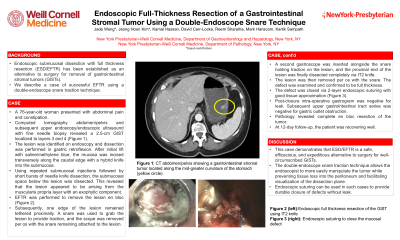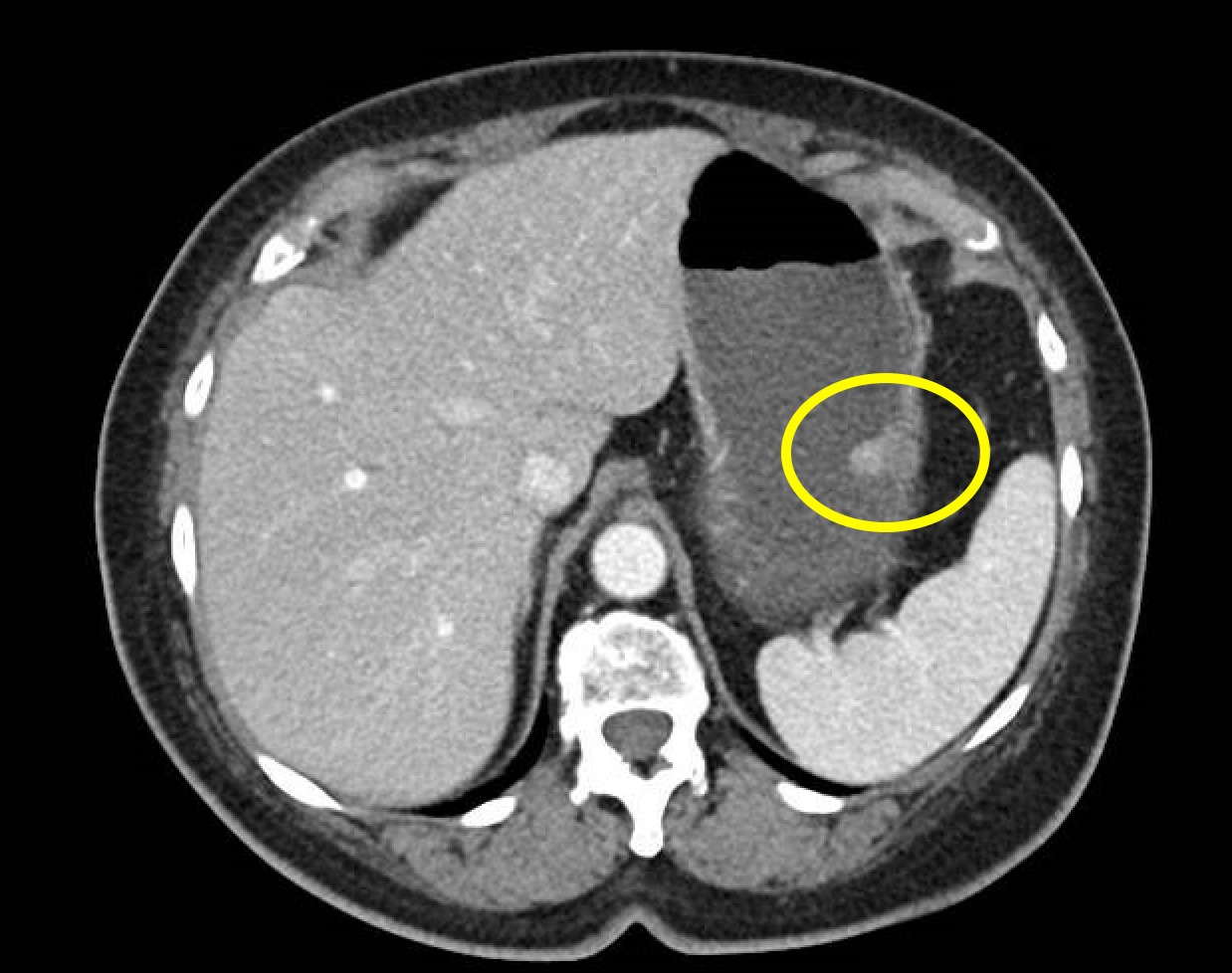Sunday Poster Session
Category: Endoscopy Video Forum
P0464 - Endoscopic Full-Thickness Resection of a Gastrointestinal Stromal Tumor Using a Double-Endoscope Snare Technique
Sunday, October 27, 2024
3:30 PM - 7:00 PM ET
Location: Exhibit Hall E

Has Audio
- JW
Jade Wang, MD
Weill Cornell Medicine
New York, NY
Presenting Author(s)
Jade Wang, MD1, Jeong Hoon Kim, MD1, Kamal Hassan, MD2, Kartik Sampath, MD1
1Weill Cornell Medicine, New York, NY; 2New York-Presbyterian/Queens, New York, NY
Introduction: Endoscopic submucosal dissection with full thickness resection (ESD/EFTR) has been established as an alternative to surgery for removal of gastrointestinal stromal tumors (GISTs). We describe a case of successful EFTR using a double-endoscope snare traction technique.
Case Description/Methods: A 76-year-old woman presented with abdominal pain and constipation. Computed tomography abdomen/pelvis and subsequent upper endoscopy/endoscopic ultrasound with fine needle biopsy revealed a 2.5-cm GIST localized to layers 3 and 4 (Figure 1). A plan was made to proceed with ESD. The lesion was identified on endoscopy and dissection was performed in gastric retroflexion. After initial lift with saline/methylene blue, the mucosa was incised transversely along the caudal edge with a hybrid knife into the submucosa. Using repeated submucosal injections followed by short bursts of needle knife dissection, the submucosal space below the lesion was dissected. This revealed that the lesion appeared to be arising from the muscularis propria layer with an exophytic component. The decision was made to perform EFTR in order to remove the lesion en bloc. Subsequently, one edge of the lesion remained tethered proximally. A snare was used to grab the lesion to provide traction, and the scope was removed per os with the snare remaining attached to the lesion. A second gastroscope was inserted alongside the snare holding traction on the lesion, and the proximal end of the lesion was finally dissected completely via IT2 knife. The lesion was then removed per os with the snare. The defect was examined and confirmed to be full thickness. The defect was closed via 2-layer endoscopic suturing with good tissue approximation.<br><br>Post-closure intra-operative gastrogram was negative for leak. Subsequent upper gastrointestinal tract series was negative for gastric outlet obstruction. Pathology revealed complete en bloc resection of the tumor. At 12-day follow-up, the patient was recovering well.
Discussion: This case demonstrates that ESD/EFTR is a safe, efficacious, and expeditious alternative to surgery for well-circumscribed GISTs. We confirm that the double-endoscope snare traction technique allows the endoscopist to more easily manipulate the tumor while preventing tissue loss into the peritoneum and facilitating visualization of the dissection plane. Lastly, endoscopic suturing can be used in such cases to provide durable closure of defects without leak.

Disclosures:
Jade Wang, MD1, Jeong Hoon Kim, MD1, Kamal Hassan, MD2, Kartik Sampath, MD1. P0464 - Endoscopic Full-Thickness Resection of a Gastrointestinal Stromal Tumor Using a Double-Endoscope Snare Technique, ACG 2024 Annual Scientific Meeting Abstracts. Philadelphia, PA: American College of Gastroenterology.
1Weill Cornell Medicine, New York, NY; 2New York-Presbyterian/Queens, New York, NY
Introduction: Endoscopic submucosal dissection with full thickness resection (ESD/EFTR) has been established as an alternative to surgery for removal of gastrointestinal stromal tumors (GISTs). We describe a case of successful EFTR using a double-endoscope snare traction technique.
Case Description/Methods: A 76-year-old woman presented with abdominal pain and constipation. Computed tomography abdomen/pelvis and subsequent upper endoscopy/endoscopic ultrasound with fine needle biopsy revealed a 2.5-cm GIST localized to layers 3 and 4 (Figure 1). A plan was made to proceed with ESD. The lesion was identified on endoscopy and dissection was performed in gastric retroflexion. After initial lift with saline/methylene blue, the mucosa was incised transversely along the caudal edge with a hybrid knife into the submucosa. Using repeated submucosal injections followed by short bursts of needle knife dissection, the submucosal space below the lesion was dissected. This revealed that the lesion appeared to be arising from the muscularis propria layer with an exophytic component. The decision was made to perform EFTR in order to remove the lesion en bloc. Subsequently, one edge of the lesion remained tethered proximally. A snare was used to grab the lesion to provide traction, and the scope was removed per os with the snare remaining attached to the lesion. A second gastroscope was inserted alongside the snare holding traction on the lesion, and the proximal end of the lesion was finally dissected completely via IT2 knife. The lesion was then removed per os with the snare. The defect was examined and confirmed to be full thickness. The defect was closed via 2-layer endoscopic suturing with good tissue approximation.<br><br>Post-closure intra-operative gastrogram was negative for leak. Subsequent upper gastrointestinal tract series was negative for gastric outlet obstruction. Pathology revealed complete en bloc resection of the tumor. At 12-day follow-up, the patient was recovering well.
Discussion: This case demonstrates that ESD/EFTR is a safe, efficacious, and expeditious alternative to surgery for well-circumscribed GISTs. We confirm that the double-endoscope snare traction technique allows the endoscopist to more easily manipulate the tumor while preventing tissue loss into the peritoneum and facilitating visualization of the dissection plane. Lastly, endoscopic suturing can be used in such cases to provide durable closure of defects without leak.

Figure: Figure 1: CT abdomen/pelvis showing a gastrointestinal stromal tumor located along the mid-greater curvature of the stomach (yellow circle).
Disclosures:
Jade Wang indicated no relevant financial relationships.
Jeong Hoon Kim indicated no relevant financial relationships.
Kamal Hassan indicated no relevant financial relationships.
Kartik Sampath indicated no relevant financial relationships.
Jade Wang, MD1, Jeong Hoon Kim, MD1, Kamal Hassan, MD2, Kartik Sampath, MD1. P0464 - Endoscopic Full-Thickness Resection of a Gastrointestinal Stromal Tumor Using a Double-Endoscope Snare Technique, ACG 2024 Annual Scientific Meeting Abstracts. Philadelphia, PA: American College of Gastroenterology.
